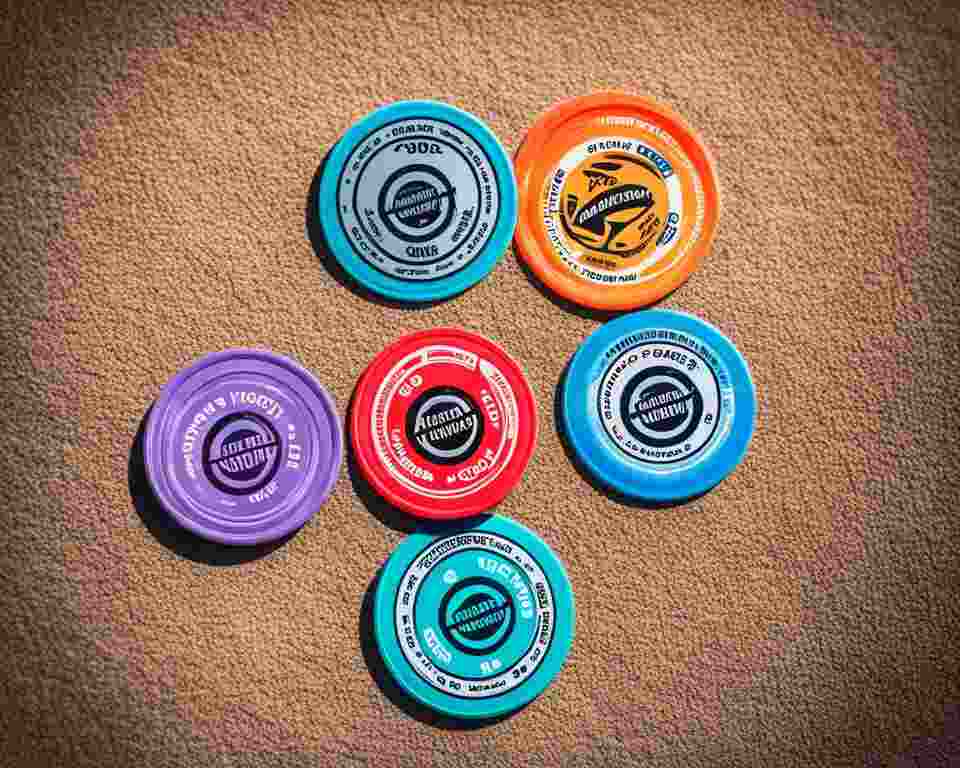When it comes to disc golf, the size and dimensions of the discs can play a significant role in the game. With the wide variety of disc golf discs available, it’s natural to wonder if they are all the same size. In this article, we will explore the different sizes, dimensions, and variations of disc golf discs. We’ll also dive into the specifications set by the PDGA (Professional Disc Golf Association) and how manufacturing processes can impact the size variance of these discs.
If you’re an avid disc golfer or just getting started, understanding the variations in disc sizes is crucial for improving your game and achieving optimal results. So, let’s dive into the world of disc golf disc dimensions and explore the factors that contribute to their size differences.
Key Takeaways:
- Disc golf discs come in various sizes and dimensions.
- The PDGA sets specifications for disc golf discs, including size requirements.
- Different types of discs, such as drivers and putters, may have size variations.
- Manufacturing processes can impact the size variance of disc golf discs.
- Choosing the right disc size is essential for optimal performance on the disc golf course.

Exploring Disc Golf Discs Dimensions and Variations
Understanding PDGA Disc Specifications
To comprehend the dimensions and variations of disc golf discs, it is important to first understand the specifications provided by the Professional Disc Golf Association (PDGA). The PDGA sets standards for disc golf discs, including their size, weight, and other specifications. By adhering to these specifications, manufacturers ensure consistency in the size and performance of discs.
Size Differences Among Disc Types: Drivers vs. Putters
Disc golf discs are designed for specific purposes, resulting in size differences among different types of discs. Drivers, which are meant for long-distance throws, are typically smaller in diameter and have sharper edges for increased speed and distance. Putters, on the other hand, are used primarily for short-range throws and have a larger diameter for better accuracy and control.
The Impact of Manufacturing on Disc Size Variance
Manufacturing processes play a significant role in the size variance of disc golf discs. Factors such as molding techniques, plastic types, and cooling processes can affect the final dimensions of the discs. Consequently, there can be slight variations in size, weight, and flight characteristics even within the same disc model. Manufacturers employ rigorous quality control measures to ensure consistency, but some variability is inevitable.
In summary, understanding the dimensions and variations of disc golf discs involves considering the PDGA specifications, recognizing the size differences among disc types, and acknowledging the impact of manufacturing processes on disc size variance.

Are All Disc Golf Discs the Same Size?
In this section, I will address the question of whether all disc golf discs are the same size. To provide a comprehensive understanding of disc golf disc sizes, I will guide you through choosing the right disc size for your game. We will also explore the various dimensions and variations among disc golf discs, taking into consideration the specifications set by the Professional Disc Golf Association (PDGA) and the impact of manufacturing on disc size variance.
Understanding PDGA Disc Specifications
The PDGA has established specific disc specifications to ensure fairness and consistency in disc golf. These specifications dictate the standards for disc golf disc sizes, including the diameter, weight, and other key dimensions. By understanding these specifications, players can make informed decisions when selecting discs for their game.
Size Differences Among Disc Types: Drivers vs. Putters
Disc golf discs can be categorized into different types, such as drivers and putters. Each type of disc serves a specific purpose and has distinct size differences. Drivers, designed for long-distance throws, often have smaller diameters and thinner profiles compared to putters, which are designed for shorter, more controlled throws. Understanding these size differences can help players choose the right disc for specific shots and playing styles.
The Impact of Manufacturing on Disc Size Variance
Manufacturing processes can influence disc size variations, albeit within the PDGA specifications. Factors like plastic type, mold variations, and cooling processes can all contribute to slight variations in disc dimensions. It’s essential to be aware of these potential variances and consider them when selecting discs for your game.
By understanding the disc golf disc sizes and their variations, as well as the impact of manufacturing processes, players can make informed decisions when choosing the right disc for their game. The next section will delve into selecting the correct disc golf disc size based on your playing style and skill level, providing valuable insights to enhance your disc golf experience.

Selecting the Right Disc Golf Disc Size for Your Game
When it comes to disc golf, choosing the correct disc size is crucial for achieving optimal performance on the course. Disc golf discs come in various sizes, and understanding the differences between them can greatly improve your throwing style and overall game. In this section, we will explore the standard disc sizes, their specifications, and the variations that exist within the sport.
Disc golf discs can vary in diameter, weight, and other characteristics, all of which play a significant role in their flight and performance. The standard size of disc golf discs adheres to specifications set by organizations such as the PDGA (Professional Disc Golf Association), ensuring fair play and competition among players. These standard sizes provide consistency and allow players to choose discs based on their individual preferences.
When selecting a disc, it’s essential to consider its diameter and weight. Disc diameter can range from as small as 15 centimeters to as large as 21 centimeters. Smaller diameter discs are typically used for more precise shots, while larger diameter discs offer increased stability and distance. Similarly, the weight of a disc can vary between 150 and 180 grams, with lighter discs generally providing greater control and finesse, while heavier discs offer more stability and power.
It’s important to note that disc golf discs are not one-size-fits-all. Different disc sizes cater to different throwing styles and skill levels. For beginners or players with slower arm speeds, lighter and more understable discs are often recommended. As players develop their skills and increase their arm speed, they may transition to heavier and more stable discs for greater distance and control.
To help players navigate the variations in disc golf disc sizes, many manufacturers provide disc golf disc size charts. These charts outline the different sizes available and provide guidance on which discs are suitable for different skill levels and throwing styles. Utilizing these resources can help ensure that you choose the right disc size that aligns with your playing abilities and goals.
In conclusion, selecting the right disc golf disc size is essential for maximizing your performance on the course. By understanding the standard sizes, specifications, and variations of disc golf discs, you can make informed choices that enhance your throwing style and overall game. Whether you prefer smaller, lighter discs for precise shots or larger, heavier discs for increased distance, finding the perfect size will allow you to achieve your best results and fully enjoy the exhilarating sport of disc golf.
The Science and Technology of Disc Golf Design
In the world of disc golf, there is more than meets the eye when it comes to disc design. The science and technology behind the creation of disc golf discs play a crucial role in shaping their performance on the course. From innovations in manufacturing processes to understanding the characteristics and variations in size, disc designers are constantly pushing the boundaries to create the perfect disc for every player’s game.
Innovation in Disc Manufacturing Processes
The manufacturing process of disc golf discs has seen significant advancements over the years. These innovations have allowed manufacturers to produce discs with precise dimensions and consistent quality. Injection molding, a commonly used technique, allows for the creation of intricate designs and detailed features that optimize the disc’s flight characteristics.

Parting Line Height and Its Effect on Disc Stability
One crucial aspect of disc design is the parting line height. This refers to the separation between the upper and lower mold halves during the manufacturing process. The parting line height can impact the stability of the disc during flight. Lower parting line heights generally result in more stable discs, while higher parting line heights can lead to discs with increased turn and less fade.
Material Differences and the Quest for the Perfect Disc
Disc golf discs are made from a variety of materials, each with its own unique characteristics. The choice of material can affect the disc’s flight performance, durability, and grip. Popular disc materials include various types of plastic, rubber, and even metal alloys. Manufacturers are constantly researching and experimenting with different materials to find the perfect combination that provides optimal flight paths, durability, and feel in the player’s hand.
Through advancements in manufacturing processes, careful consideration of parting line height, and the quest for the perfect disc material, the science and technology behind disc golf design continue to evolve. These developments ensure that players have access to a wide range of disc golf disc types, each with its own characteristics and size variations. Understanding these advancements and finding the right disc golf disc size is key to maximizing your performance on the course.
Conclusion
In conclusion, when it comes to disc golf discs, size and dimensions matter. It is crucial for players to understand the different options available to optimize their game. By considering the specifications set by the Professional Disc Golf Association (PDGA), acknowledging the size differences among disc types, recognizing the impact of manufacturing processes, and selecting the right disc size, players can elevate their performance on the disc golf course.
Understanding the PDGA disc specifications ensures that you are aware of the standard sizes and dimensions for disc golf discs. This knowledge enables you to make informed decisions when choosing discs that align with your throwing style and skill level. Whether it’s a driver or a putter, knowing the size differences among disc types allows you to harness their unique characteristics to your advantage.
Manufacturing processes can have an impact on disc size variance. By being aware of this, you can select discs from reliable brands that prioritize consistency in their manufacturing. Finding the right disc size that suits your throwing technique and comfort level is essential for achieving optimal results and maximizing your enjoyment of this thrilling sport.
So, next time you step onto the disc golf course, remember the importance of disc size. By understanding the variations in size and dimensions, considering the PDGA specifications, and choosing the right disc for your game, you are setting yourself up for success. Stay focused, keep practicing, and watch your disc fly with precision and control!


